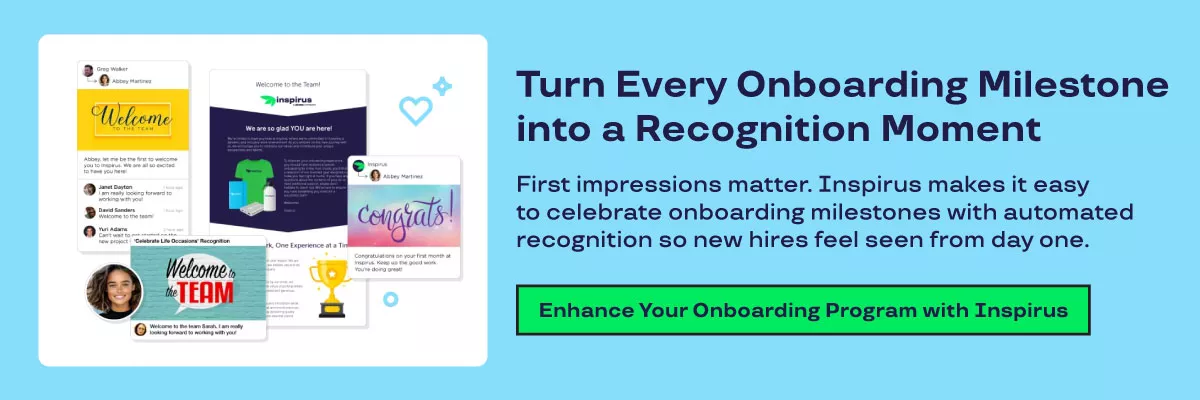
Effective Employee Onboarding and Training: Build Trust with Communication
August 20, 2025
First impressions set the tone for the entire employee experience. Discover how to transform onboarding from paperwork into a culture-building, trust-boosting experience that drives engagement and loyalty from day one.
Too often, companies mistake orientation for onboarding. Handing new hires a stack of forms, pointing out the coffee maker, and calling it a day might cover the basics, but it does nothing to spark engagement, instill confidence, or showcase what makes your culture unique.
Employee onboarding is more than an administrative process. It’s the first opportunity to create a meaningful connection between employees and your company — and it can determine whether they stay, thrive or quickly move on.
In this blog, we’ll explore why employee onboarding matters, the key elements of a strong program and practical ways to create an experience that drives engagement and retention from day one.
The Benefits of Effective Employee Onboarding
A strong onboarding program helps new hires settle into both their role and the company culture, ensuring they can contribute quickly and confidently. And the data leaves no room for doubt:
- Employees who attend a structured orientation program are 69% more likely to remain at the company for at least three years
- Organizations with a strong onboarding process enjoy upwards of 70% in improved productivity
- 78% of organizations who invested in onboarding reported increases in revenue in the last fiscal year — 64% of those companies saw positive gains in most of their organizational KPIs, and 54% saw significant gains in employee engagement metrics.
- HR Cloud reports that effective onboarding can increase retention by as much as 82%.
Yet despite these results, 60% of companies admit they don’t set clear objectives or benchmarks to measure onboarding success. That means most organizations miss out on the chance to intentionally shape one of the most impactful moments in the employee lifecycle.
Onboarding clearly has the power to drive employee engagement and retention, but only if it’s done with purpose. So, how do you create a program that delivers?
A Checklist for Successful Employee Onboarding
Society for Human Resources (SHRM) New Hire Onboarding article offers some key questions you should answer and operationalize to give new employees that great first impression you're after:
- When will onboarding start?
- How long will it last?
- What impression do you want new hires to walk away with at the end of the first day?
- What do new employees need to know about the culture and work environment?
- What role will HR play in the onboarding and training process? What about direct managers? Co-workers?
- What kind of goals do you want to set for new employees?
- How will you gather feedback on the onboarding program and measure its success?
When you take these questions seriously and act on them, onboarding shifts from a simple administrative task to an intentional process that welcomes employees into the culture, sets expectations and establishes a foundation for growth. Beyond the logistics, though, it’s the people-centered strategies that set new hires up for success in their new roles.

Start Building Trust on Day One of Employee Onboarding and Training
Have you gone through a corporate training program that was held offsite and included several professional peers going through the same program? During the training sessions that lasted for several weeks, the head trainer spoke to the training class as a whole throughout the entire onboarding experience. However, did the head trainer ever pull you aside to determine how you were progressing through the training program?
Onboarding and training is the ideal time to establish the level of trust that puts new employees at ease. If new employees believe that you have their back, they are more likely to go all-in with your company. The attrition rate for onboarding and training can soar higher than 50%. Building trust through effective communication should lower your new employee attrition rate.
Here are a few ways to build trust with your new hires from the start.
#1 Provide Clear Direction During Onboarding
New employees want to know how to get from point A to point B. You give new employees direction during onboarding by describing the many ways members of your team can move up in your company. During training, providing direction is especially important during role-playing sessions. For example, a restaurant management training session that includes role-playing might ask each trainee to handle a customer complaint. The job of the training team is to give advice on how to handle customer complaints, as well as point out when a trainee succeeds in assisting a role-playing customer. Providing direction during training can help boost the confidence of every new employee.
#2 Resolve Conflict During Onboarding and Training
Conflict comes in many forms for new employees that go through the onboarding and training process. For onboarding, conflict can arise with the technology used to move a new employee through the process. For example, filling out onboarding paperwork by using an onsite Wi-Fi connection can lead to slow page downloads. An effective communicator stays on top of the progress of a new employee going through the onboarding process.
During training, conflict can arise between a new employee and a veteran employee, as well as between two trainees. Remaining calm and finding common ground are the keys to resolving conflicts through effective communication techniques.
#3 Give a Warm Welcome
Going through onboarding and training is like attending the first day of school. Trepidation runs through a new employee’s veins because of the fear caused by the unknown. As a human resources professional, it is your job to alleviate the tension many new employees have during onboarding and training. Making new team members feel at ease goes a long way towards improving employee engagement.
#4 Assign a Peer Ambassador
Starting a new job can feel overwhelming for any employee whether they’re in the office, hybrid or fully remote. Pairing new hires with a peer ambassador gives them a friendly go-to resource for all the small but important questions that come up in the first weeks: everything from “How do we actually use this tool?” to “Who do I talk to about X?”
A Peer Ambassador is not a mentor, rather a co-worker who acts as a “go-to” resource for all the little questions that are bound to come up as they start their new job. Introduce the new employee to their peer ambassador on Day One and allow some time for them to connect. This simple step helps them build relationships, reduces uncertainty and creates a stronger sense of belonging from the start.
#5 Schedule Onboarding Meetings
Announce new hires internally before they start so the entire workforce knows who is starting, when and what role they play. Coordinate structured onboarding meetings with the team members and subject matter experts (SMEs) on tools and processes they will need to use on Day One, so that they get the right information from the right people at the right time. A strong onboarding process helps to engage and retain employees from their first day of employment.
Don't forget to encourage the new hires to be proactive in making connections. Employees may feel they need “permission” to reach out to others on their own — especially those co-workers who may be in higher level positions or belong to other work teams. Remove these barriers by making it clear that you encourage employees to reach out and engage with others as often as they’d like.
#6 Encourage Collaboration
As your new employee’s peer ambassador is making introductions during the employee’s first few weeks on the job, they’ll likely get a sense of different cross functional groups or teams that they may have an interest in.
Personal growth and development play a large role in employee engagement. In fact, the 2022 LinkedIn Learning Report indicates that “opportunities to learn and grow” is the #1 driver of a great work culture. Those first few days and weeks on a new job is the time when new employees can see where growth opportunities may exist.
While it may seem counterintuitive to burden new employees with additional information during this hectic introductory onboarding process, it’s really the perfect time to plant the seed for future development.
#7 Check In with New Employees Regularly
Make sure you’re staying in touch with, and on top of, your new employee’s experience and any questions or issues they may be facing. Check in with them regularly just to see how they’re doing or ask if there’s anything they need to help them be successful in their role. Connect them with others internally, as needed, to get the answers and support they need.
Onboarding is one of the key drivers of a positive employee experience. New hires especially need to feel valued, engaged and connected, so getting off to a strong start creates the momentum that will propel new employees to a fulfilling employee journey.
Adding Employee Recognition to the First Days on the Job
One element that often gets overlooked during onboarding is employee recognition. Onboarding is the first chance to show employees that they made the right choice in joining your company. Employee recognition plays a powerful role in that. A few small, intentional moments of appreciation can go a long way toward building connection and reinforcing company values right from the start.
Here are a few ways to weave recognition into employee onboarding:
- Day One Welcome: Encourage managers and peers to send welcome messages through your employee recognition platform or share them during team meetings. A note, shoutout, or even a small welcome gift can help new hires feel like they belong.
- Early Wins: Recognize progress in the first 30–60 days, whether it’s completing training, contributing to a project, or achieving a date-based milestone. Acknowledging these milestones boosts confidence and motivation.
- Ongoing Touchpoints: Continue recognition through regular check-ins and team interactions. Peer-to-peer recognition is especially powerful for helping new hires build relationships.
- First-Year Milestones: Celebrate the employee’s one-year anniversary with personalized recognition, whether that’s a lunch with the team, points to redeem for a meaningful gift, or a public acknowledgment of their contributions.
By weaving recognition into onboarding, you turn what could be a checklist-driven process into an experience that feels human and supportive. Employees who feel recognized early are more confident in their role, more engaged in their work and more likely to stay for the long term.
Employee recognition platforms like Inspirus Connects make this process simple and consistent. Automated recognition can be set to trigger at important onboarding milestones, from a day-one welcome message to celebrating a 90-day mark or first-year anniversary. This ensures every new hire feels seen without adding extra work for managers or HR.

Boost Productivity with a Strong Start
Rallying new employees during training to embrace teamwork is much more than an emotional appeal for unity. Teamwork also boosts employee productivity, whether it is a 20-year pro or a new employee that is still in training. Effective communication that encourages the development of teamwork is an essential component to increasing productivity.
Effective communication during onboarding and training is the key to building lasting professional relationships. By helping employees build connections early, integrating recognition into milestones, and offering a supportive experience, new employees can build professional bonds with other team members that remain strong for years to come and become productive quickly.
At the end of the day, employee onboarding sets the tone for the entire employee experience. Get it right, and you build trust, employee engagement and retention from day one. Get it wrong, and you risk losing talent before they’ve even found the coffee maker.




